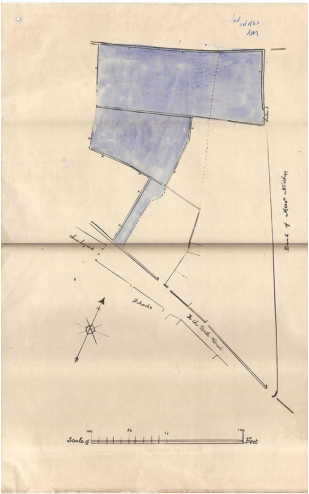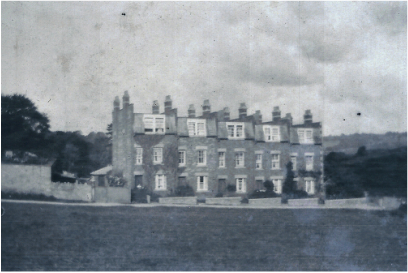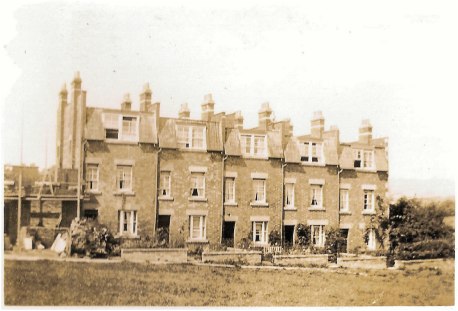
Valens Terrace
November 2014
Information and photographs provided by Hugh Sawyer, whose ancestors built the terrace.
Left: The terrace in course of construction, adding number 1.
Have you ever wondered about the row of houses at Valens Terrace? They are just down from the Selwyn Hall and are completely different to every other house in the village. This story tells how and why they were built.
We know a great deal about Valens Terrace because it was developed by a local man John Hardy, son of Charles Hardy, one of Box's earliest postmasters.[1]
We know a great deal about Valens Terrace because it was developed by a local man John Hardy, son of Charles Hardy, one of Box's earliest postmasters.[1]
|
John Hardy
John Hardy (1842 - 1927) was a local businessman, who ran a grocer's shop on the High Street. The building is still there, now called Hardy House (formerly the Comrades Legion Club). Have you noticed the family name carved in the top of the pillars? He bought two plots of land in 1897 to the north of the Vicarage, including the Valens Terrace site and what is now part of The Wilderness grounds.[2] John Hardy was a well-known person in the county of Wiltshire. His local reputation arose because it was he who uncovered the extent of the Roman Villa remains in Box. He was mentioned in a document produced by the nationally-renowned restoration architect and archaeologist, Harold Brakspear, in 1904.[3] Brakspear was an important conservationist working on Bath Abbey, Windsor Castle and locally at Lacock Abbey and Great Chalfield Manor. And, of course, it was due to his efforts that St Thomas à Becket was restored in 1896. |
Valens Terrace was named after a coin found during
the excavation, which had on it the head of the Roman Emperor Valens (364 - 378).[4] [Incidentally, how do you pronounce Valens? In previous times residents used the correct pronunciation Vale-lens which has now modified to Vallance. There is another story to be told about how standard English has replaced the local Wiltshire dialects.]
John Hardy was far from being a cynical property developer. He was one of the original trustees of the Methodist Chapel in Box (opened 1897) and his obituary records that during the excavations he supplied tools and refreshments to encourage free workers in order that costs could be reduced.[5] It was John Hardy's son-in-law, Frank Sawyer, who actually undertook the building of the terrace. Frank was born in 1869, and married Elizabeth Hardy in 1894. They first lived in number 2 (as shown in the 1911 census), then in number 1, when it was added.
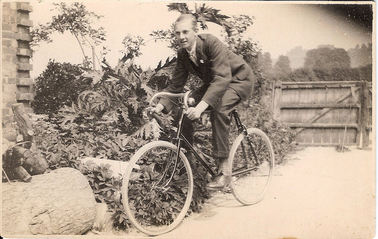 Frank's son, Hubert (aka Bunno) Sawyer, around 1920. See the jagged bricks, on the left for the addition of number 1.
Frank's son, Hubert (aka Bunno) Sawyer, around 1920. See the jagged bricks, on the left for the addition of number 1.
Building the Terrace
We can trace when and how the terrace was built from later documents. The Conveyance on the death of Frank Sawyer's widow, Elizabeth, in 1962, reads:
Upwards of thirty years ago the dwelling house Number 1 Valens Terrace was erected to the South of Number 2 Valens Terrace as a continuation of the Terrace on part of the land delineated in the plan drawn on a Conveyance dated 7th June 1897 made between Jane Elliott of the one part and the said John Hardy of the other part.
We can trace when and how the terrace was built from later documents. The Conveyance on the death of Frank Sawyer's widow, Elizabeth, in 1962, reads:
Upwards of thirty years ago the dwelling house Number 1 Valens Terrace was erected to the South of Number 2 Valens Terrace as a continuation of the Terrace on part of the land delineated in the plan drawn on a Conveyance dated 7th June 1897 made between Jane Elliott of the one part and the said John Hardy of the other part.
|
We can be satisfied that the land was purchased by John Hardy in 1897 from Jane Elliott but it was developed piecemeal, the build date of number 1 being somewhat later possibly just before 1932.
A local anecdote has it that bricks were used because they had been left over from Box Tunnel. If this is true it is likely that this was the 1906 re-roofing work of the eastern section rather than the original brickwork in the western section in 1841. |
In the plan above, the upper part is the Valens Terrace site and the lower part is where the Roman remains were found and which is now part of The Wilderness.
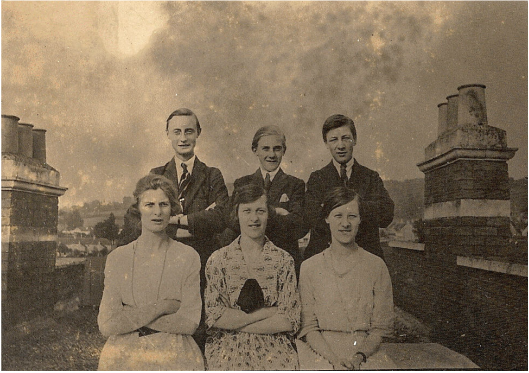
Conclusion
The houses at Valens Terrace are unique in the village, built in brick rather than the usual local Box stone. This wasn't just an accident.
They were built to be a fashion statement by John Hardy. They are working class properties befitting his Methodist beliefs.
These houses are stunningly original in the village, reflecting Hardy's Edwardian principles of a modern society for new, educated workers in Box, whilst venerating the village's inheritance of classical history.
The houses at Valens Terrace are unique in the village, built in brick rather than the usual local Box stone. This wasn't just an accident.
They were built to be a fashion statement by John Hardy. They are working class properties befitting his Methodist beliefs.
These houses are stunningly original in the village, reflecting Hardy's Edwardian principles of a modern society for new, educated workers in Box, whilst venerating the village's inheritance of classical history.
Above: The Sawyer children sitting on top of number 2 before 1920 are: Back: Herbert, Hubert and Gilbert and Front: Doris (Barnett), Muriel (Rumming) and Florence Amy (Miller).
References
[1] The details and photos here have been kindly supplied by Hugh Sawyer
[2] Mark Corney, The Roman Villa at Box, 2012, Kobra Trust, p.21, 23 and 26
[3] Wiltshire Archaeological and Natural History magazine, 1904
[4] Box WI pamphlet
[5] Bath Chronicle December 1927
[1] The details and photos here have been kindly supplied by Hugh Sawyer
[2] Mark Corney, The Roman Villa at Box, 2012, Kobra Trust, p.21, 23 and 26
[3] Wiltshire Archaeological and Natural History magazine, 1904
[4] Box WI pamphlet
[5] Bath Chronicle December 1927

